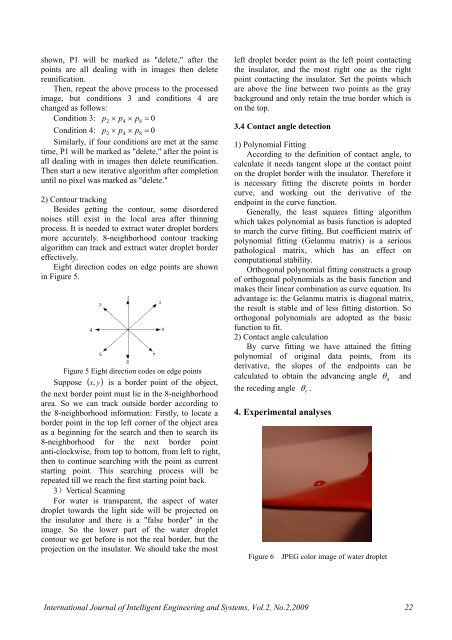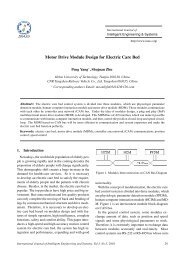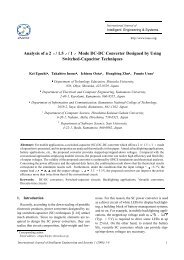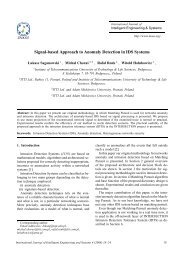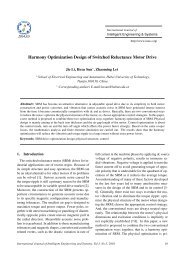A New Diagnosis Method on Insulators with Measuring ... - inass
A New Diagnosis Method on Insulators with Measuring ... - inass
A New Diagnosis Method on Insulators with Measuring ... - inass
Create successful ePaper yourself
Turn your PDF publications into a flip-book with our unique Google optimized e-Paper software.
shown, P1 will be marked as "delete," after thepoints are all dealing <strong>with</strong> in images then deletereunificati<strong>on</strong>.Then, repeat the above process to the processedimage, but c<strong>on</strong>diti<strong>on</strong>s 3 and c<strong>on</strong>diti<strong>on</strong>s 4 arechanged as follows:C<strong>on</strong>diti<strong>on</strong> 3: p2 p4 p8 0C<strong>on</strong>diti<strong>on</strong> 4: p2 p4 p8 0Similarly, if four c<strong>on</strong>diti<strong>on</strong>s are met at the sametime, P1 will be marked as "delete," after the point isall dealing <strong>with</strong> in images then delete reunificati<strong>on</strong>.Then start a new iterative algorithm after completi<strong>on</strong>until no pixel was marked as "delete."2) C<strong>on</strong>tour trackingBesides getting the c<strong>on</strong>tour, some disorderednoises still exist in the local area after thinningprocess. It is needed to extract water droplet bordersmore accurately. 8-neighborhood c<strong>on</strong>tour trackingalgorithm can track and extract water droplet bordereffectively.Eight directi<strong>on</strong> codes <strong>on</strong> edge points are shownin Figure 5.Figure 5 Eight directi<strong>on</strong> codes <strong>on</strong> edge pointsSuppose x, yis a border point of the object,the next border point must lie in the 8-neighborhoodarea. So we can track outside border according tothe 8-neighborhood informati<strong>on</strong>: Firstly, to locate aborder point in the top left corner of the object areaas a beginning for the search and then to search its8-neighborhood for the next border pointanti-clockwise, from top to bottom, from left to right,then to c<strong>on</strong>tinue searching <strong>with</strong> the point as currentstarting point. This searching process will berepeated till we reach the first starting point back.3)Vertical ScanningFor water is transparent, the aspect of waterdroplet towards the light side will be projected <strong>on</strong>the insulator and there is a "false border" in theimage. So the lower part of the water dropletc<strong>on</strong>tour we get before is not the real border, but theprojecti<strong>on</strong> <strong>on</strong> the insulator. We should take the mostleft droplet border point as the left point c<strong>on</strong>tactingthe insulator, and the most right <strong>on</strong>e as the rightpoint c<strong>on</strong>tacting the insulator. Set the points whichare above the line between two points as the graybackground and <strong>on</strong>ly retain the true border which is<strong>on</strong> the top.3.4 C<strong>on</strong>tact angle detecti<strong>on</strong>1) Polynomial FittingAccording to the definiti<strong>on</strong> of c<strong>on</strong>tact angle, tocalculate it needs tangent slope at the c<strong>on</strong>tact point<strong>on</strong> the droplet border <strong>with</strong> the insulator. Therefore itis necessary fitting the discrete points in bordercurve, and working out the derivative of theendpoint in the curve functi<strong>on</strong>.Generally, the least squares fitting algorithmwhich takes polynomial as basis functi<strong>on</strong> is adoptedto march the curve fitting. But coefficient matrix ofpolynomial fitting (Gelanmu matrix) is a seriouspathological matrix, which has an effect <strong>on</strong>computati<strong>on</strong>al stability.Orthog<strong>on</strong>al polynomial fitting c<strong>on</strong>structs a groupof orthog<strong>on</strong>al polynomials as the basis functi<strong>on</strong> andmakes their linear combinati<strong>on</strong> as curve equati<strong>on</strong>. Itsadvantage is: the Gelanmu matrix is diag<strong>on</strong>al matrix,the result is stable and of less fitting distorti<strong>on</strong>. Soorthog<strong>on</strong>al polynomials are adopted as the basicfuncti<strong>on</strong> to fit.2) C<strong>on</strong>tact angle calculati<strong>on</strong>By curve fitting we have attained the fittingpolynomial of original data points, from itsderivative, the slopes of the endpoints can becalculated to obtain the advancing angle a andthe receding angle r .4. Experimental analysesFigure 6JPEG color image of water dropletInternati<strong>on</strong>al Journal of Intelligent Engineering and Systems, Vol.2, No.2,2009 22


